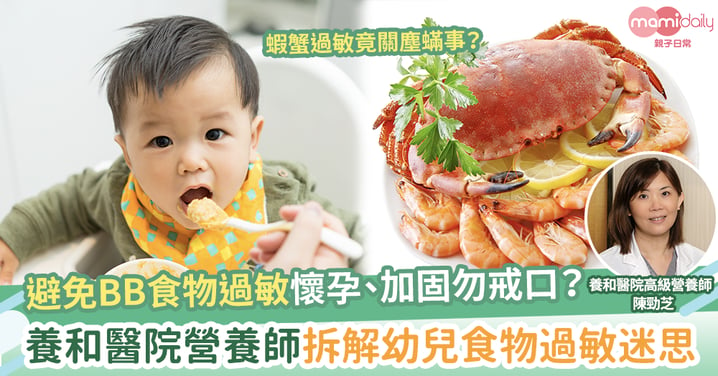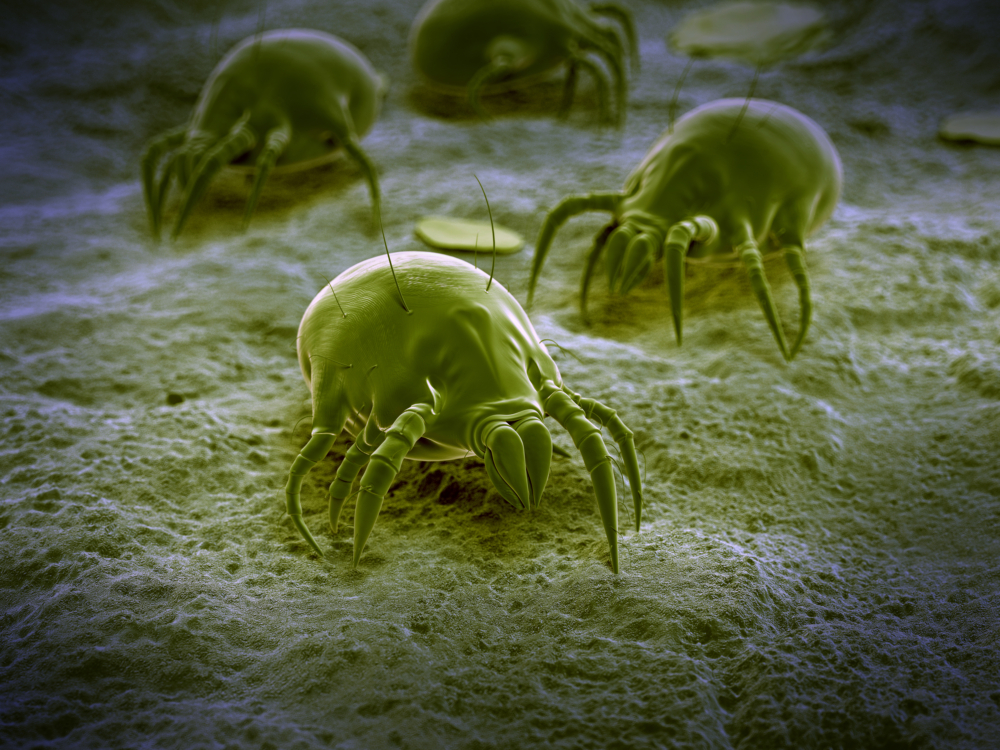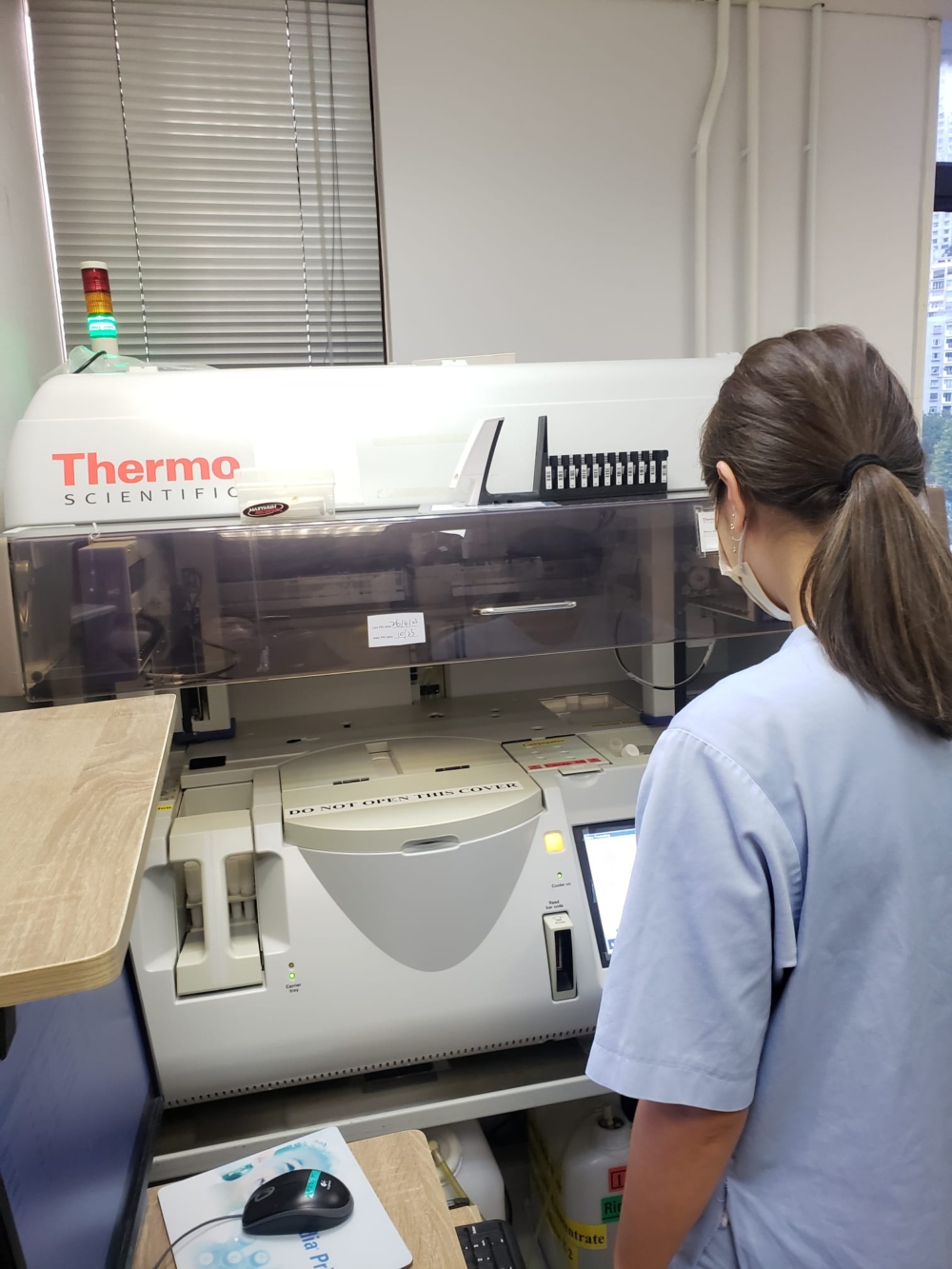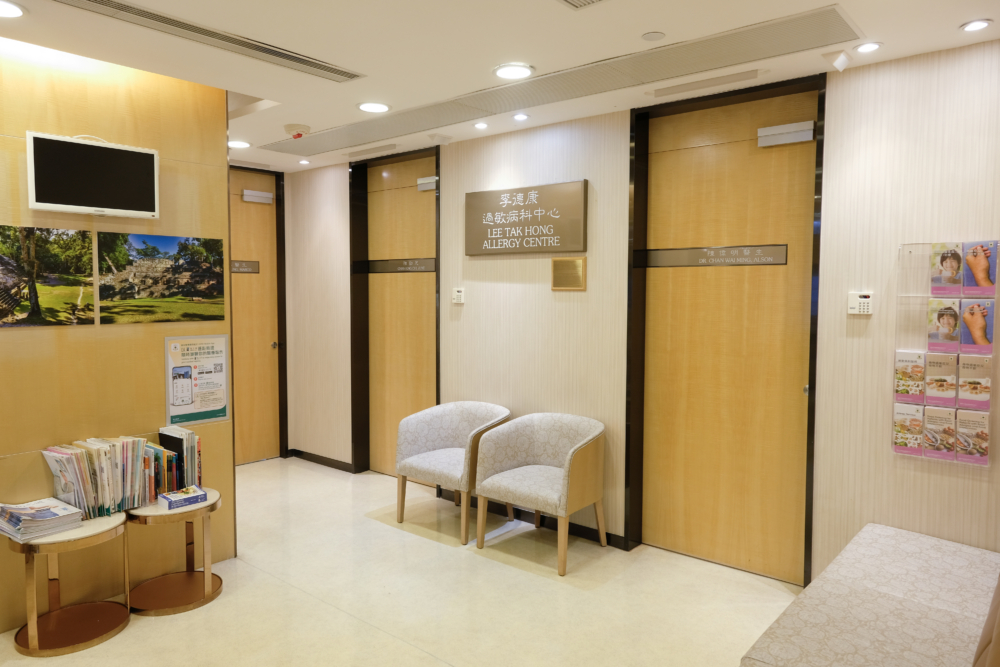
蝦蟹過敏竟關塵蟎事?懷孕、加固時勿戒口?養和營養師拆解幼兒食物過敏迷思
時有聽聞外國小朋友食用花生後,身體出現嚴重過敏反應甚至死亡,因此一提起食物過敏,爸媽都大為緊張。為了避免小朋友有食物過敏反應,媽媽由懷孕開始便戒口,到BB加固期時,又刻意避開有機會致敏的食物,究竟有否幫助?有說蝦蟹過敏與屋企常見的塵蟎有關,究竟是甚麼一回事?立刻找來養和醫院高級營養師陳勁芝為大家解答疑問!
問1: 食物過敏有甚麼徵狀?
答:在醫學上,食物過敏症是指身體免疫系統錯誤攻擊食物中的蛋白質,令身體產生各種反應,而且往往在兩小時內發生,有些甚至在進食後幾分鐘內出現徵狀。而過敏反應很大機會重覆出現,每次進食,就算只進食少量,也可出現徵狀,輕微的有皮膚痕癢、流眼水、流鼻水、嘔吐及咳嗽,嚴重的話會呼吸困難、血壓下降,甚至休克。

養和醫院高級營養師陳勁芝表示,一般來說,身體第一次接觸致敏原時不會有反應,因免疫系統尚未將它歸類為致敏原,但此時身體會開始製造免疫球蛋白E (IgE),為再次接觸致敏原作好準備。當再次接觸同一致敏原時,免疫系統就會作出攻擊,並引發各種過敏反應。食物過敏反應通常於進食後兩小時內迅速出現,並會重複發生,即是其後每次進食都會「出事」。
問2 :為甚麼有時BB第一次進食致敏食物便有過敏反應?
答: 除了透過進食外,身體亦可透過皮膚或呼吸道接觸食物。一般來說,身體經由腸道先接觸食物,會有較高耐受性,即出現過敏的機會較低;相反,皮膚作為身體的防禦屏障,特別是患有濕疹的皮膚,如先經皮膚接觸到外來物質如食物,身體較容易認定該食物為致敏原,這在醫學上稱為「雙重致敏原接觸假定 Dual Allergen Exposure Hypothesis」。
過往研究亦指出,家中環境的花生物質多寡會影響患上花生過敏的風險,而患濕疹的兒童亦較容易有食物過敏。有媽媽不明為何BB第一次進食某種致敏食物便有反應,可能是因為BB身體早已透過皮膚或吸入方式接觸致敏原。
問3 :在香港,食物過敏有多普遍?
答:根據本港於2012年的研究,估計本港約有4.8%的0-14歲兒童患有不同程度的食物過敏,情況與歐美國家相近。當中以貝類海產(1.4%)、牛奶( 0.7%)、雞蛋(0.5%)、及花生(0.5% )最為常見。其後亦有研究指,香港約有16.6%的7至10歲的兒童對最少一種食物有過敏傾向(即有關的特異性IgE呈陽性反應) 。 日常診症中,最常見的是牛奶、雞蛋、花生及蝦蟹過敏。

問4 :進食抑或吸入致敏原的情況較多?
答:根據本中心於2019-2021年的數據顯示,較多人對吸入性致敏原呈陽性反應,最多是麈蟎(60%),其次是貝殼類海產(30%),及花粉(25%)。其實塵蟎過敏於香港甚為普遍,亦是鼻敏感(過敏性鼻炎)的常見成因。 鼻敏感是香港兒童的常見慢性病,據本港於2021年的研究指出,近五成6至7歲的小朋友患有鼻敏感,數字亦比過去二十年多。有趣的是,蝦蟹某些致敏原與塵蟎致敏原的結構相似,而部分塵蟎過敏患者於進食蝦蟹時亦會有過敏反應。因此,對於有蝦蟹過敏的小朋友,家長可同時留意他們是否對塵蟎過敏。


問5 :食物過敏會遺傳?為免BB 出現食物過敏,媽媽在懷孕期及BB在加固期戒口有幫助嗎?
答:雖然食物過敏不會直接遺傳至下一代,但如果父母患有食物過敏或其他過敏病,如濕疹或鼻敏感,子女患有食物過敏的風險則較高。不少媽媽為了子女著想,懷孕期間避免進食高致敏食物,但過往的研究並沒顯示此舉有助預防過敏,有些研究反指過度戒口可能增加子女患食物過敏的風險,胡亂戒口可能影響孕婦的營養攝取及胎兒健康。
於2000年,即約二十年前,美國兒科學會(American Academy of Pediatrics)建議小朋友不應太早接觸致敏食物,所以建議1歲才飲牛奶,兩歲才食蛋、3歲才食花生。不過,有關建議已早於2008年作出修訂,並指延遲進食容易致敏食物對預防兒童食物過敏症並沒有幫助。2015年,英國的著名研究LEAP STUDY更指出,患花生過敏的高危嬰兒,在嬰幼兒時期避免進食花生反而更容易患上花生過敏。 醫學界近年陸續發現,延遲進食高致敏食物會增加食物過敏風險,因此,多個學會均建議在加固期進食高致敏食物。現時亞太兒科過敏呼吸及免疫學會亦建議「不應延遲引進高致敏食物」。
總括而言,BB在加固期戒食高致敏食物對預防食物過敏並沒有幫助,建議在加固期間逐少引入花生、蛋及其他高致敏食物,讓免疫系統及早認識這些食物對身體無害,以免作出錯誤攻擊及引起過敏反應。
問6 :如何判斷小朋友有否食物過敏?
答:其實一般人很難單憑進食後的徵狀去判斷是否有食物過敏。進食某類食物後感到不適,不一定是食物過敏,有機會是食物不耐症引起,例如身體未能提供足夠酵素消化食物,跟免疫系統發動攻擊無關。根據過往數據,認為自己有食物過敏的人士當中,經過測試及醫生評估後,只有三分之一至一半人士患有食物過敏。想知道小朋友有否食物過敏,對哪些食物過敏,建議諮詢醫生意見,看看有否需要接受過敏測試。
過敏血液檢測 可助找出過敏誘發因子
血液檢測又稱為特異性 IgE 檢測,是其中一種過敏診斷工具。透過測量血液中特異性 IgE 抗體的濃度,可了解患者接觸致敏原後的反應風險程度。一般來說,0.35 kUA/L以上屬陽性結果,濃度愈高,接觸該致敏原後有反應的風險愈大。但須注意,這數值與患者身上會出現的過敏徵狀種類並無直接關連,醫生需配合臨床病徵及病歷以作診斷。現時的血液檢測可以找出多種過敏誘發因子,包括花粉、黴菌、食物和動物皮屑等。準確找出致敏原,對醫生診斷、避免接觸致敏原,及日後的整體治療均有幫助。

 養和李德康過敏病科中心
養和李德康過敏病科中心
查詢:2835 8430
資料來源:
食物過敏
Boye JI.
Food allergies in developing and emerging economies: need for comprehensive data on prevalence rates.
Clin Transl Allergy. 2012 Dec 20;2(1):25. doi: 10.1186/2045-7022-2-25. PMID: 23256652; PMCID: PMC3551706.
https://www.ncbi.nlm.nih.gov/pmc/articles/PMC3551706/
香港食物過敏率
Ho MH, Lee SL, Wong WH, Ip P, Lau YL. Prevalence of self-reported food allergy in Hong Kong children and teens--a population survey.
Asian Pac J Allergy Immunol. 2012 Dec;30(4):275-84. PMID: 23393907.
https://pubmed.ncbi.nlm.nih.gov/23393907/
Li J, Ogorodova LM, Mahesh PA, Wang MH, Fedorova OS, Leung TF, Fernandez-Rivas M, Mills ENC, Potts J, Kummeling I, Versteeg SA, van Ree R, Yazdanbakhsh M, Burney PGJ, Wong GWK.
Comparative Study of Food Allergies in Children from China, India, and Russia: The EuroPrevall-INCO Surveys.
J Allergy Clin Immunol Pract. 2020 Apr;8(4):1349-1358.e16. doi: 10.1016/j.jaip.2019.11.042. Epub 2019 Dec 16. PMID: 31857266.
https://pubmed.ncbi.nlm.nih.gov/31857266/
Loh W, Tang MLK.
The Epidemiology of Food Allergy in the Global Context.
Int J Environ Res Public Health. 2018 Sep 18;15(9):2043. doi: 10.3390/ijerph15092043. PMID: 30231558; PMCID: PMC6163515.
https://www.ncbi.nlm.nih.gov/pmc/articles/PMC6163515/
花生過敏風險
Brough HA, Kull I, Richards K, Hallner E, Söderhäll C, Douiri A, Penagos M, Melén E, Bergström A, Turcanu V, Wickman M, Lack G.
Environmental peanut exposure increases the risk of peanut sensitization in high-risk children.
Clin Exp Allergy. 2018 May;48(5):586-593. doi: 10.1111/cea.13111. Epub 2018 Mar 23. PMID: 29405462.
https://pubmed.ncbi.nlm.nih.gov/29405462/
Fewtrell M, Bronsky J, Campoy C, et al. Complementary Feeding: A Position Paper by the European Society for Paediatric Gastroenterology, Hepatology, and Nutrition (ESPGHAN) Committee on Nutrition. Journal of pediatric gastroenterology and nutrition 2017; 64(1): 119-32.
美國兒科學會
2008指引
Greer FR, Sicherer SH, Burks AW; American Academy of Pediatrics Committee on Nutrition; American Academy of Pediatrics Section on Allergy and Immunology.
Effects of early nutritional interventions on the development of atopic disease in infants and children: the role of maternal dietary restriction, breastfeeding, timing of introduction of complementary foods, and hydrolyzed formulas. Pediatrics. 2008 Jan;121(1):183-91. doi: 10.1542/peds.2007-3022. PMID: 18166574.
https://pubmed.ncbi.nlm.nih.gov/18166574/
2019 指引
Greer FR, Sicherer SH, Burks AW; COMMITTEE ON NUTRITION; SECTION ON ALLERGY AND IMMUNOLOGY.
The Effects of Early Nutritional Interventions on the Development of Atopic Disease in Infants and Children: The Role of Maternal Dietary Restriction, Breastfeeding, Hydrolyzed Formulas, and Timing of Introduction of Allergenic Complementary Foods. Pediatrics. 2019 Apr;143(4):e20190281. doi: 10.1542/peds.2019-0281. Epub 2019 Mar 18. PMID: 30886111.
https://pubmed.ncbi.nlm.nih.gov/30886111/
Chan ES, Abrams EM, Hildebrand KJ, Watson W.
Early introduction of foods to prevent food allergy. Allergy Asthma Clin Immunol. 2018 Sep 12;14(Suppl 2):57. doi: 10.1186/s13223-018-0286-1. PMID: 30275847; PMCID: PMC6157280.
https://www.ncbi.nlm.nih.gov/pmc/articles/PMC6157280/
關於母親飲食和母乳餵餔建議
EAACI guideline: Preventing the development of food allergy in infants and young children (2020 update)
Susanne Halken, Antonella Muraro, Debra de Silva, Ekaterina Khaleva, Elizabeth Angier, Stefania Arasi, Hasan Arshad, Henry T. Bahnson, Kirsten Beyer, Robert Boyle, George du Toit … See all authors
First published: 12 March 2021
https://doi.org/10.1111/pai.13496
Tham EH, Shek LP, Van Bever HP, et al.
Early introduction of allergenic foods for the prevention of food allergy from an Asian perspective-An Asia Pacific Association of Pediatric Allergy, Respirology & Immunology (APAPARI) consensus statement. Pediatric allergy and immunology : official publication of the European Society of Pediatric Allergy and Immunology 2018; 29(1): 18-27.
The Effects of Early Nutritional Interventions on the Development of Atopic Disease in Infants and Children: The Role of Maternal Dietary Restriction, Breastfeeding, Hydrolyzed Formulas, and Timing of Introduction of Allergenic Complementary Foods. Pediatrics. 2019 Apr;143(4):e20190281. doi: 10.1542/peds.2019-0281. Epub 2019 Mar 18. PMID: 30886111.
https://pubmed.ncbi.nlm.nih.gov/30886111/
Fleischer DM, Chan ES, Venter C, et al. A Consensus Approach to the Primary Prevention of Food Allergy Through Nutrition: Guidance from the American Academy of Allergy, Asthma, and Immunology; American College of Allergy, Asthma, and Immunology; and the Canadian Society for Allergy and Clinical Immunology. The journal of allergy and clinical immunology In practice 2021; 9(1): 22-43.e4.
Fewtrell M, Bronsky J, Campoy C, et al. Complementary Feeding: A Position Paper by the European Society for Paediatric Gastroenterology, Hepatology, and Nutrition (ESPGHAN) Committee on Nutrition. Journal of pediatric gastroenterology and nutrition 2017; 64(1): 119-32.
過敏性鼻炎-香港於2021年統籌一項全港兒童敏感病研究調查(ISAAC)
https://www.hku.hk/press/press-releases/detail/23934.html
https://www.hku.hk/press/press-releases/detail/c_23934.html






